
You’ll need a checkup first
Before you can get that Hollywood smile, it’s critical to have a dental exam to ensure that your mouth is healthy. “Dental problems such as cavities and gum disease need to be addressed before bleaching,” says Eric Klein, a dentist in Norwalk, CT. Here’s why it’s so important: “Teeth whitening that is peroxide-based is meant to whiten the enamel layer, not the structure inside the tooth near the nerve,” says Jennifer Jablow, a cosmetic dentist in New York City. “If the enamel is not intact, because of cavities or other damage, the whitening gel can leach into the nerves tissue and cause irreversible damage.”
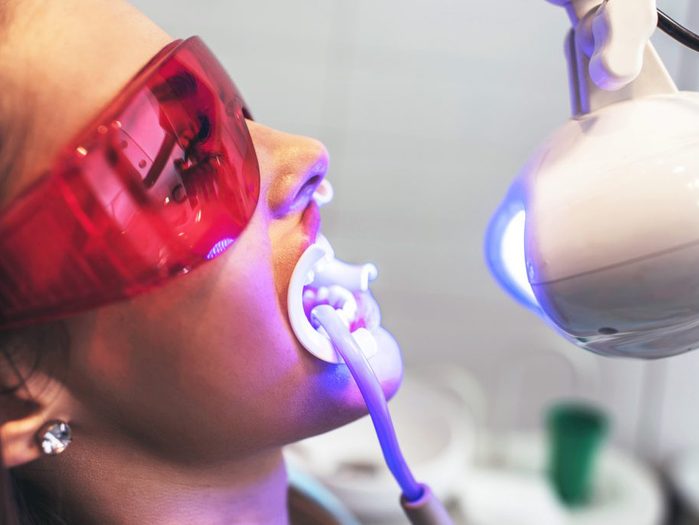
Slow and steady beats fast and furious
We’re all immediate gratification junkies, but bleaching your teeth several shades in one day with an in-office laser treatment may not always be the best option. “The pros of LED-based in-office whitening treatments are that patients can get their teeth significantly whiter in a short amount of time,” says Jablow. But those treatments can also cause sensitivity, you still have to maintain the results at home and they are too strong to do more than once a year.”
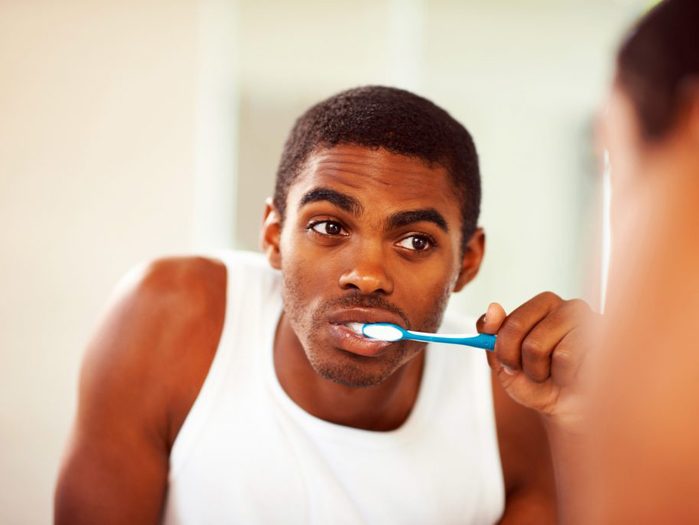
You can try this at home
While in-office, light-activated procedures can jumpstart the whitening process, professional take-home kits sold in dental offices work very well to keep your pearly whites as bright as possible. Or, skip the pricey procedures and try one of these at-home products for a whiter smile.
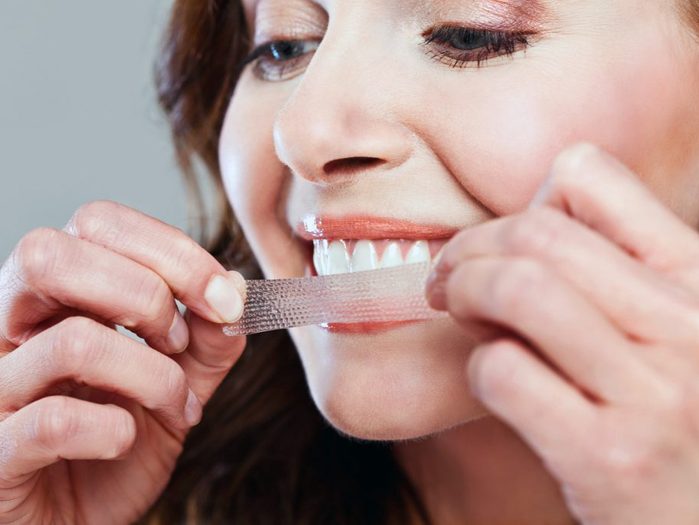
It’s not one and done
In fact, you’ll probably need to continue using those custom trays or other whitening treatments at home if you don’t want to see your sparkle lose its luster. Teeth whitening requires commitment and maintenance. For easy at-home touch-ups, try the Intelliwhite Platinum Whitening Pen. It comes with a mouthguard to help you avoid getting the gel on your gums, and the pen makes it easy to paint the whitener on wherever you need it most. Just don’t use tooth-whitening products too often, though. Too much teeth whitening could increase tooth sensitivity and even cause tooth decay.

You might have to watch what passes your lips
Certain foods and beverages such as tea, coffee, wine, and even blended green juices can cause tooth discolouration. Cutting them out of your diet—or limiting them—will help your teeth stay white post-procedure. At the same time, certain foods such as cauliflower, strawberries, seeds, and nuts may help whiten teeth and may speed up the whitening process.

Go OTC if you don’t need TLC
Yes, you can absolutely walk into a drugstore and grab a teeth-whitening product off the shelf—if you’re looking to whiten by just a shade or two. “For non-sensitive teeth in need of only slight whitening, over-the-counter products may be satisfactory,” explains Dr. Klein. “Whitening strips or mold lights using a mild peroxide solution may work well.” Try APA White Duo with no-slip white film strips that mold to teeth to lock in whitening agents. Peppermint oil treats sensitivity and potassium nitrate shields sensory nerves under the gum line, so you won’t be clutching your jaw in pain, as with some pro treatments. This kit earns its high price tag with impressive whitening results in under a week.
For a more budget-friendly option, try Crest 3D Luxe White Strips Professional Effects, which uses enamel-safe whiteners to erase stains and yellowing in three days, with full results in 20 days. You can also try brushing your teeth with the Go Smile On The Go Sonic Blue Teeth Whitening System, an electric toothbrush that has blue light technology to speed whitening. Apply the whitening gel along with your regular toothpaste and brush for two minutes, twice daily, for pearlier whites in two days.
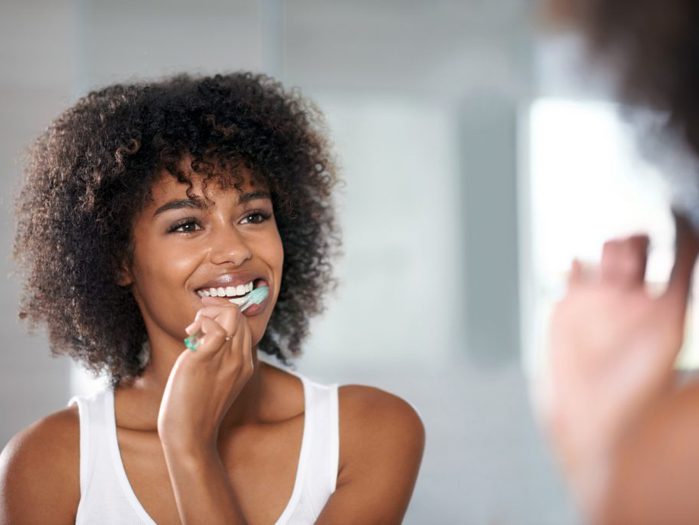
Toothpastes don’t really do the trick
Unfortunately, toothpastes that advertise whitening powers don’t stick around long enough to deliver on their promise. “Some have whitening solution in them, but usually they’re not on the teeth long enough to be effective,” Klein says. And they won’t intrinsically change the internal colour of your teeth effectively. Instead, they use abrasive ingredients to remove surface stains from things like cigarette smoke and coffee. (To avoid surface stains, whip up this caffeine-free bevvy when you’re craving coffee.) Whitening formulas can also make teeth sensitive over time.
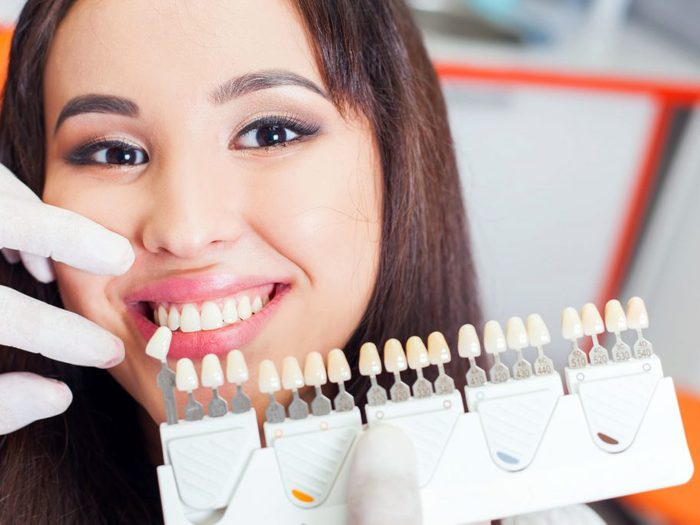
Fake teeth may not whiten
According to the American Dental Association, some veneers, crowns, and fillings won’t brighten up with whitening treatments. So you could end up with mismatched colouring if you don’t replace those older restorations. If you do choose to replace older restorations, expect to wait seven to 10 days after bleaching to pick the shade of a new crown or veneer, in order to get the best match.
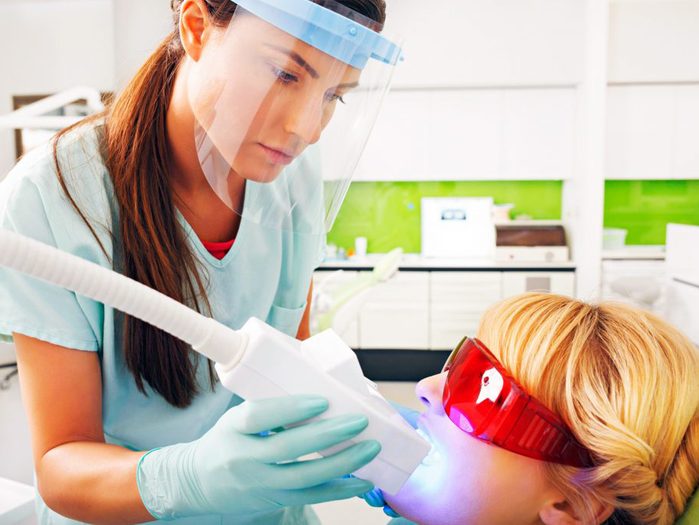
Not all stains come out easily
If your teeth were overexposed to fluoride during your first eight years of life, you may have a cosmetic condition called “fluorosis“—white spots or fine, chalk-like lines on the surface of your teeth. These stains can be difficult to treat and may require multiple bleaching treatments to improve.
Medically reviewed bySusanne Jackson, DDS.
Next, don’t miss the worst pieces of health advice on the Internet.
